|
further into the hive mind
Globalisation is not new. if it isn't disgusting enough to know that the biggest
corporations of the day had a global hold before the rise of Nazism...it is sickening to see how the
allied forces of WWII treated the Nazi scientists responsible for horrific crimes against humanity
as an asset to America in the post WWII 'cold war' scenario.
|
|
"Acoustic Kitty" !
In [1967] a project known as "Acoustic Kitty"
the Directorate of Science and Technology sought to train a surgically altered cat, wired with transmitting
and control devices, to become a mobile, eavesdropping platform. In its first test, the cat was run over
by a taxi. According to Victor Marchetti:
"they slit the cat open, put batteries in him, wired him up. The tail was used as an antenna.
They made a monstrosity. They tested him and tested him. They found he would walk off the job
when he got hungry, so they put another wire in to override that. Finally, they're ready.
They took it out to a park bench and said "Listen to those two guys. Don't listen to anything else
not the birds, no cat or dog just those two guys!" ... They put him out of the van, and a taxi comes
and runs him over. There they were, sitting in the van with all those dials, and the cat was dead!"
This heavily redacted memo appears to express the view that cats can be altered and trained to perform
certain tasks. At the same time, it notes that "the environment and security factors in using this technique
in a real foreign situation force us to conclude that, for our [intelligence] purposes, it would not be
practical."
|
If this happened in1967...what on earth can they do now?
|
|
NEO-Earth - The open prison
As well as a "great safeguard" for dealing with sex offenders, the minister said satellite tracking could be a "prison without bars" for minor offenders where jail terms would lead to prison overcrowding.
He believes tracking would tell police if offenders had been near a crime scene, and boost public confidence in community supervision.
Tony Blair later backed the idea, saying: "Where there are prolific offenders, even when they come out of prison again it's important that they are tracked and monitored so that we can make sure that these people realise that they've got a choice every single day.
"They can either go straight or they are going to go back inside again."
BBC
|
|
Notice how, [in the stories repeatedly parroted in the mainstream media]
in 'clockwork orange' style: they pick a man who has injuries after a knife attack....
in the film - a violent criminal was used to justify mind control. We can see pedophilia being used to justify Geo-fencing proposals
a recovery procedure on a victim of crime or a punitive measure on a perpetrator will always make the public responsive to the measures they propose...
I have no doubt that such technology could be used for the benefit of suffering people, but ask yourself if you trust corporations
to use this technology in a responsible manner...
organisations which have contracts with primary defense industires via a cushy board link to the Pentagon & the Ministry of defense:
That's right the people who brought you this
|
|
now bring you this:
Brain machine interface
Bio-fusion? Neo-futurist trans-human agenda? Do we have a choice?
|
Decoding Minds, Foiling Adversaries
Information warfare is no longer just about machines; it is also about how users think.
By Sharon Berry
Whether a threat comes from pilot error or enemy aggression, scientists are finding that multisensor mapping and analysis of the brain lead to systems with human-machine interfaces that can correct human error, aid counterintelligence work and guard against attacks.
A technology, known as bio-fusion, combines sensors to examine biological systems to understand how information and neural structures produce thought and to display the thought in mathematical terms. By creating an advanced database containing these terms, researchers now can look at brain activity and determine if a person is lying, receiving instructions incorrectly or concentrating on certain thought types that may indicate aggression.
Mapping human brain functions is not new; however, using multiple components of the electromagnetic spectrum allows investigators to produce a different snapshot of the brain to gain additional insight.
Dr. John D. Norseen, systems scientist for embedded systems, Lockheed Martin Aeronautics Company, Marietta, Georgia, is developing the bio-fusion concept further. "If you went into a hospital and had an EEG [electroencephalogram], it is just telling you if your electrical patterns look fine, but maybe your magnetic components are not functioning properly," he explains. "What I am encouraging is multisensor analysis of the brain--looking at many areas of the spectrum to get a different picture."
After the information is placed in a database, a composite model of the brain is created. "Now, just by getting an EEG, we can begin to interpolate a better hyperspectral analysis," Norseen says. "The model provides us amplified information."
Simple interaction with subjects has been used to test the system. A researcher shows a picture to a person or asks a person to think of a number between one and nine. Information is gathered and displayed on a monitor much like on a television. It shows that the person is thinking about the number nine. The researcher then tells the person to say the same number, an action that appears in another part of the brain, the parietal region. "By looking at the collective data, we know that when this person thinks of the number nine or says the number nine, this is how it appears in the brain, providing a fingerprint, or what we call a brainprint," Norseen offers.
"We are at the point where this database has been developed enough that we can use a single electrode or something like an airport security system where there is a dome above your head to get enough information that we can know the number you're thinking," he adds. "If you go to an automatic teller machine and the sensor system is in place, you could walk away and I would be able to access your personal identification code."
Norseen shares that the defense industry is interested because this type of data is culturally independent information. Worldwide, most individuals process certain information in the same regions of the brain.
Brainprints are unique to each person. While the number nine will appear in the same brain areas of different people, it still occurs as a unique signature of how a person specifically thinks of the number. Biology has the tendency to create things that are self-similar, Norseen says. "The proteins that lay down your fingerprints are the same protein materials that lay down the neurons of the brain," he offers.
He also has been asked by military and law enforcement agencies to show how brainprints can be used to determine probable cause, which could be used for an anti-terrorism situation. "If someone is walking through the airport and he goes through the security checkpoint and we get a feeling that this person is preoccupied with certain numbers or certain thought types that may indicate hostility or aggression we could ask him questions and verify the answers. Then it gives you probable cause to say, 'Sir/Ma'am, may we step aside with you and ask you additional questions?' It allows you to find a problem set within a large group." Norseen is confident that if such a system were fully developed it would be accepted if it meant everyone would be safer at the airport gate. The data he collects may not only show probable cause but also truth verification, he adds. The brain, which uses energy, does not want to expend it needlessly, he says. If someone is telling the truth, it is kept on the outside portion of the brain in low-energy domain areas of the brain. "If someone starts to light up in more areas of the brain and at a higher energy level, it means that the person is now starting to confabulate or obfuscate." Research so far indicates a 90 to 95 percent accuracy rate.
Now that bio-fusion research has developed beyond the initial stages and the database of what, how and where thoughts occur in the brain is mature, scientists are looking at information injection, a contentious issue, Norseen admits. The concept is based on the fact that human perception consists of certain invariant electromagnetic and biochemical lock-and-key interactions with the brain that can be identified, measured and altered by mathematical operations. If researchers can re-create the inverse function of what has been observed, they gain the ability to communicate or transmit that information back--intact or rearranged--to the individual or someone else, Norseen says. "When you get down to the mathematical properties, information injection is beginning to be demonstrated."
The brain is very susceptible to accepting information that is either real and comes from its own memory mechanisms or from injection from an outside source, Norseen notes. "I am sure you have memories of when the lawn was being cut in late summer and of the smell of the chlorophyll," he says. "The chlorophyll would then evoke other memories. I could possibly ping you with a light sequence or with an ELF [extremely low field] radiation sequence that will cause you to think of other things, but they may be in the area that I am encouraging. Those are direct ways in which I can cause the inverse function of something to be fired off in the brain so that you are thinking about it. I have now caused you to think about something you would not have otherwise thought about."
By using information injection, a person could be isolated from a group and made to believe that something is happening, while others in the group are being left alone. Likewise, someone at a command post monitoring information on a screen could be affected. Some experts believe that adversaries now are designing techniques that could affect the brain and alter the human body's ability to process stimuli.
Norseen hopes his work will lead to filters and walls that would block intentional or unintentional corrupted information. "Look at the incident in Japan where a lot of young children were watching a cartoon, and it caused many of them to have cerebral seizures," he explains. "The information that came over the screen showed lights at particular timing and pulsing frequencies and in a certain combination of colors that caused the brain to go into a seizure. If you were alerted, you could slow parts of the video stream or change the timing mechanisms so the stream would not have a negative impact on the brain."
Modifying corrupt information may not always be enough. Norseen compares this type of offensive attack to cyberspace attacks in which viruses infiltrate computers. "Now there's potential for the viruses to affect the video stream," he says. "They can be corrected or defended against, but more complex protective measures would have to be installed. Instead of electronic warfare countermeasures and software virus countermeasures, we're getting into information countermeasures."
Norseen believes his work with bio-fusion and the human-machine interface is revolutionary and that a new set of questions must be asked when looking at the state of information warfare. "We're so concerned with information corrupting our machines that we're spending millions of dollars for our protection against people writing Trojan horses. What about the human side of the human-machine interface? What's happening to the operator?" he asks.
Some experts believe that the information operator is a weak spot in the nation's military assets. Additionally, some developers in the field see Russia, China and several Middle Eastern countries as more advanced than the United States in this area.
"The United States is not behind other countries [in this field]," Norseen argues. "Government leaders are very aware of the information threat to the soldier, but they are concerned about being careful to work on the defensive side. However, other countries may be more interested in the offensive/exploitative side. When we talk about our ability to have information dominance, we know that our machines can be better and faster, but sometimes we underplay what could happen to the operator. We are aware that the enemy is going to go after the mind of the operator to bring down the system, not by corrupting the machine but by corrupting the individual soldier or decision maker."
One of the challenges of addressing the human side of the human-machine interface is creating quantitative means to measure the impact of information on the human brain and neurophysiology. "We're looking at incidents such as Columbine or teenagers playing games like Doom," he says. "How are they being influenced negatively? There have been no quantitative measures like what I've been developing. When we can show that, we can identify more ways to protect the human side of the human-machine envelope."
Bio-ethics specialists are reviewing bio-fusion and its applications, specifically neural emulation software. Rather than involving a human, the software captures human mental activity and can be tested against psychological attacks. Software corrections and builds then would be put in place to protect users. "Our ethics people are excited about this because this is a way to protect people without subjecting them to experimentation," he says.
Synthetic reality is another approach to protection. "If I pick up a phone right now, is it a person I talked to or a recording of the person's voice? Or was it synthetically generated?" Norseen asks. Scientists can look at components of a personality in a software application, select certain components of the personality and create a synthetic person. "We can look at 150 things that Joe Smith, a special forces agent, does. He smiles 20 percent of the time. He has a tick in his eye. We can extract those features and create mini-morphs of him--we create identical Joes on the computer. I want to communicate with Joe about secret information, but I want other parts of my system to communicate with avatars of Joe. If someone tried to find our communication, they would have to sift through a lot of other communications that looked an awful lot like Joe. I would bury Joe in the noise of himself."
Scientists have found that human errors also could possibly be corrected using external means. A recent discovery determined that error correction coding parameters of the brain involve the globus pallidus, a powerful error correction mechanism. When people consider a decision, they visualize it and talk to themselves and send it to the kinesthetic nerve to say, "Do you feel good about this?" Then it comes back through the globus pallidus for one more visual look, and people decide to do it or not do it--a go/no go decision. "If we proceed and do something that is in error, our globus pallidus comes into play," Norseen notes. "It is connected to the kinesthetic nerve, which is ineffable. It can't talk to the 'talk' areas of the brain, but it can send signals that go back through the stomach, and that's why you get that sick feeling in your stomach. Something's wrong here."
For example, a pilot in the cockpit and the aircraft's system both may hear an instruction, "Come right 90 degrees." The human hears the instruction, but the brain may actually have heard 80 degrees. "Even though the pilot may confirm 90 degrees, the system can see that the person actually misunderstood," Norseen notes. "The machine can say, 'I'm monitoring you and even though you said you're coming 90 degrees, your brainprint analysis indicates that you only understood 80 degrees. I request you come an additional 10 degrees so we're in compliance with the overall command of the system.' If we can show the globus pallidus 'go/no go' display of error correction, we can create a checklist that says, 'Am I in accordance with the globus pallidus?'" Today, more than 70 percent of all accidents are caused not by the machine but by humans using information incorrectly, Norseen says.
Many of Norseen's ideas are still in early development. "As the areas of the brain that reflect behavioral components of the human are identified and understood, and as the software components are laid down, I can begin to conduct tests on the synthetic human without using a real human," he says. "I can find out more things about the human now in a year than it took me in the past 10 years ¼ where I can actually launch a truth verification system or a knowledge warfare protection system. To do what? Enhance, strengthen and protect the human side of the human-machine interface in any domain, any weapon system," he concludes.
Decoding Minds, Foiling Adversaries By Sharon Berry
|
|
Brain machine interface
BMI - Brain Machine Interface: Technically, this term defines the project on which scientists are working, or the type of Hardware and Software used to
connect the Brain or Nervous system to a computer. Please understand that this chip is designed to work within the nerves and soft tissue of the body in order to gather electrical signals from the body and/or transmit electrical signals received from the outside to the body through the nerves!
Brain Machine Interface is simply the computer software that will send out the signal to the chip; therefore, BMI is the software that will interact with the chip, to control the chip and the person in whom the chip is inserted!
* MMEA, Multiple Micro Electrode Array: Multiple Micro Electrode Array, this is the actual Chip. This chip will be surgically implanted directly into a human nerve or into specific area of the brain. The Chip at the moment is a little smaller than a Tic Tac breath mint. The chip implanted into the pioneer, a Professor Kevin Warwick, had 100 Electrodes; each electrode looks like a small needle and is capable of detecting electric signals traveling through the nervous system and also sending electrical signals to the nervous system, this was all performed via a RF (Radio Frequency) device connected to the MMEA.
|
"The essential requirements for a working multiple-microelectrode to record from biological tissue include:
1. A conductor forming the active electrode and the tracks, e.g. indium-tin oxide (ITO), titanium nitride;
2. An electrical insulation layer, e.g. polysiloxane, polyimide, or silicon nitride;
3. The microelectrode must be biocompatible, resistant to a physiological saline environment and sterilisation, and easily maintained in cell culture conditions for many days or weeks."[Neuronal Networks Electrophysiology Laboratory, School of Biomedical Sciences, University of Nottingham Medical School]
cutting edge
Brain-Machine Interfaces: Current and Future Applications
"The Defense Sciences Office is interested in new proposals in BRAIN MACHINE INTERFACES. This new program represents a major thrust area for DSO that will comprise a multidisciplinary, multipronged approach with far reaching impact. Brain Machine Interfaces: The brain takes inputs and generates output through the electrical activity of neurons. DARPA is interested in creating new technologies for augmenting human performance through the ability to non-invasively access these codes in the brain in real time and integrate them into peripheral device or system operations.
Stanford
|
|
|
|

DARPA - Fundamental Research at the
[Bio:Info:Micro] Interface
The Defense Advanced Research Projects Agency (DARPA) is announcing a new program called "Fundamental Research at the [Bio:Info:Micro] Interface." The goal of the program is to create interdisciplinary teams of researchers drawn from the fields of biology, information technology and microsystems technology and who are primarily from institutions of higher education.
The biology or [BIO] component of the program includes the disciplines studying biology from the molecular and cellular level through the organismal and population level. The information technology or [INFO] component of the program includes, but is not limited to, the disciplines contributing to the development of theories, algorithms, models and simulations, and scalable parallel and distributed systems. The microsystems technology or [MICRO] component of the program includes, but is not limited to, the disciplines contributing to the development of sensors, materials, microfluidics, micromechanics, microphotonics, microelectronics and large-scale systems created from such components.
|
|
The program will enable teams of investigators from [BIO], [INFO] and [MICRO] to work collaboratively to address fundamental research issues at the intersections of these three broadly defined areas. DARPA anticipates that long-term outcomes of this program will include the creation of new interdisciplinary research communities and the emergence of new science and technology that will provide a foundation for revolutionary systems to satisfy future national and defense needs.
DARPA believes that revolutionary solutions to important science and technology problems are likely to emerge from scientists and engineers who are working at the frontiers of their respective disciplines and are also engaged in dynamic interdisciplinary interactions. DARPA further believes that biology is now particularly well poised to contribute to advances in other disciplines and to benefit substantially from interactions with those disciplines. Initially, DARPA seeks to stimulate the formation of interdisciplinary teams of investigators - including students and postdoctoral fellows - to promote the development of enabling concepts and technologies that will contribute to fundamental cross-disciplinary advances. An explicit intention of this program is to stimulate the development of a new generation of scientists and engineers who will focus on, and become fluent in, performing science and technology at the intersection(s) of biology with other disciplines. For this reason, this RA focuses primarily on U.S. institutions of higher education.
The following are examples of areas that might be addressed by interdisciplinary teams of scientists and engineers. These are offered merely as suggestions. The list is not in priority order and is not meant to limit the scope of ideas that DARPA is willing to entertain.
Biologically inspired engineering of complex artificial systems across vastly different size scales from nanometers to meters and large-scale, globally distributed systems;
Development of biologically inspired algorithms and models for computation and their realization, possibly including systems of hybrid devices;
Cellular engineering of synthetic production of materials and chemicals via the application of concepts of developmental biology to the biosynthesis of composite materials or via the generation of novel enzymes and pathways;
Computational neural science applied to the interaction of humans and systems, addressing both the measurement of neural phenomena to control systems and systems control of neural phenomena;
Engineering novel chemical and biological reagents for micro-scale assays;
Platforms for studying and mimicking biological processes such as synthesis, signaling, regulation and control;
Modeling and simulation of the dynamic behavior of complex biological systems (from the molecular level to the population level); and
Techniques and micro-scale platforms for nondestructively observing and affecting cells and subcellular components in real time to help discover the equivalent of the "device physics" for biological systems.
This solicitation calls for grant proposals from U.S. institutions of higher education that intend to produce new science by collaboratively sharing resources (e.g., data, personnel, prototype devices, computing) and results with the larger community. DARPA's intention is to make multiple awards covering a wide range of high-risk/high-payoff interdisciplinary efforts. The vehicle to fund selected proposals will be a three-year annually funded grant, with two optional one-year extensions. A typical budget is expected to be between $500,000 and $2,000,000 per year.
Although a preproposal is not required, proposers are strongly encouraged to submit one by FEBRUARY 18, 2000, in advance of a full proposal. DARPA will respond with a recommendation to propose or not propose by March 3, 2000.
The date for submission of a full proposal is MARCH 31, 2000.
|
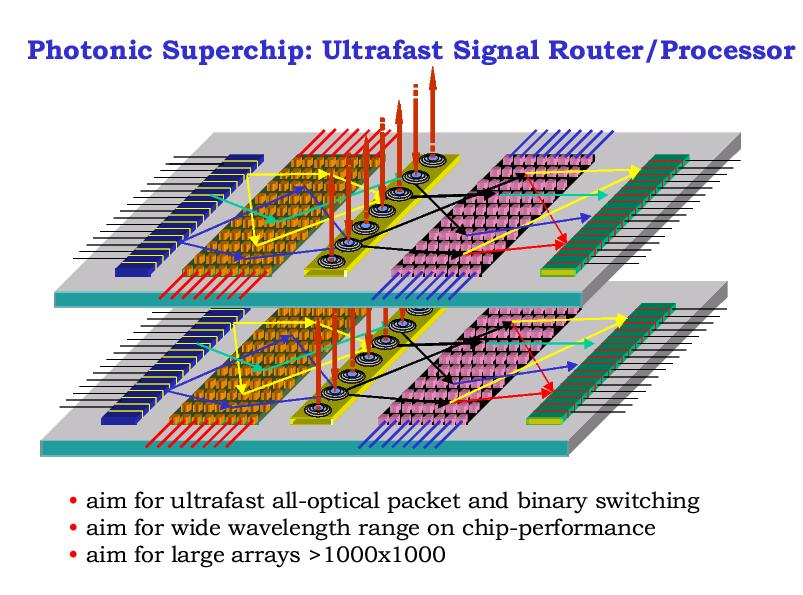 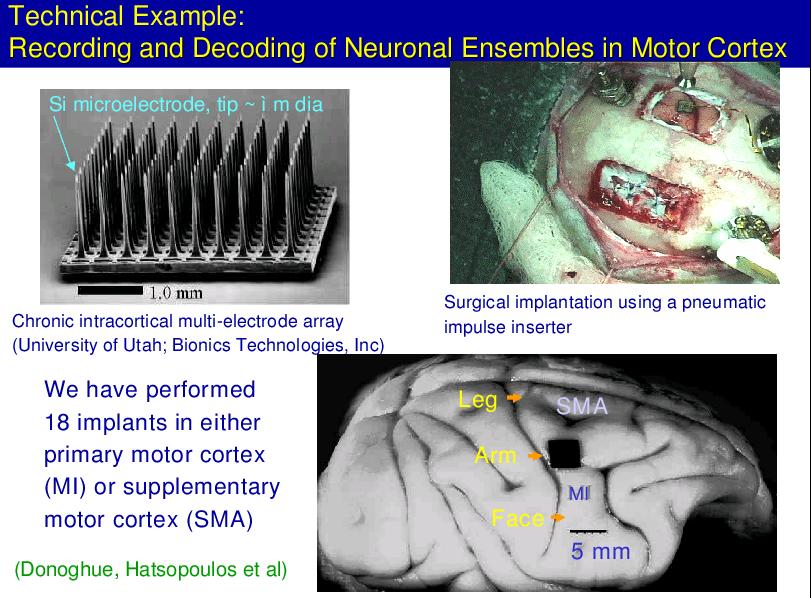 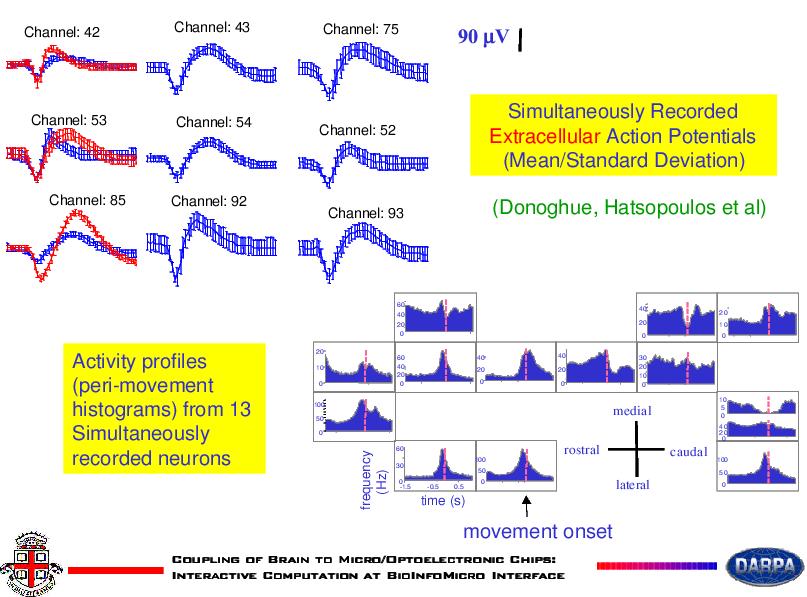
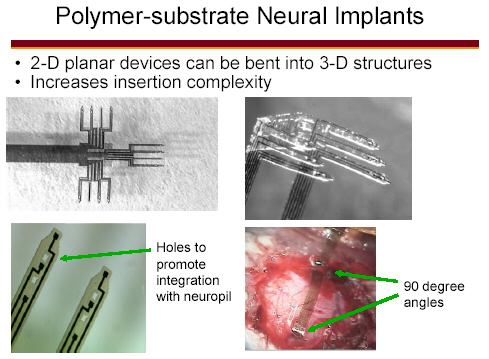 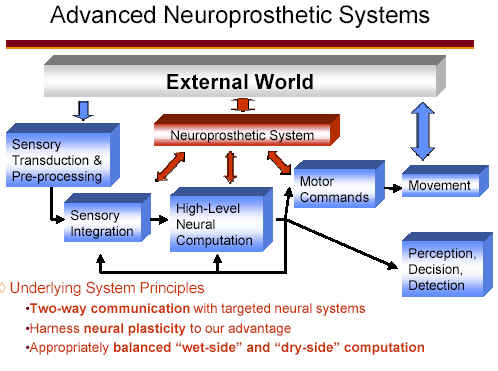
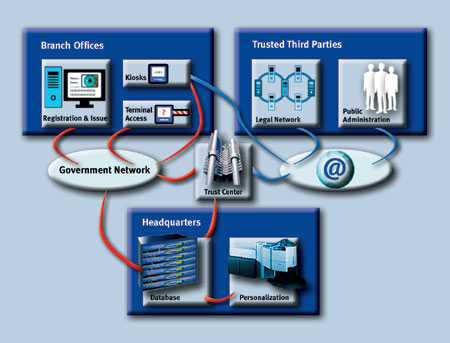
|
Mission accomplished:
Fundamental Research at the [Bio: Info: Micro] Interface
In collaboration with other DARPA offices, the Bio:Info:Micro Program brought together interdisciplinary teams of researchers from the fields of biology, microsystems technology, and information technology to collectively address fundamental research issues at the intersections of biology and other fields. Common to all research efforts was the development of novel computational and microsystems tools to study biological systems ranging from single cells to the mammalian brain. An equally important component of each effort was the development of computational and microsystems tools that model the functional capabilities of biological systems.
Program accomplishments include -
Development of a cognitive neural prosthetic that decodes motor signals.
Development of the suspended microchannel resonant biosensor yielding extraordinarily high sensitivity.
Development of continuous flow methods for rapid fractionation of bioparticles including separation based on size and binding affinity for antigens. The latter was a microfluidic analog of magnetically assisted cell separation that was integrated on a chip for the first time.
Demonstration of DNA moving in channels under 100 nm in width resulting in an uncoiled DNA linear molecule; this DNA linearization lead to development of a quantitative understanding the behavior of DNA in such a channel. - Darpa
|
|
|
|
|
First brain-machine interface tested in a monkey
Waldemar Perez writes "Scientists at Duke University and MIT tested the first ever neuro-implant in a monkey's brain for a brain-machine control interface. The monkey controlled a robotic arm 600 miles away performing such tasks as reaching for food. It holds great promise for prosthetic implants. http://www.eurekalert.org/releases/duke-mca111000.html"
Excerpt: " 'One most provocative, and controversial, question is whether the brain can actually incorporate a machine as part of its representation of the body,' [the researcher] said. 'I truly believe that it is possible...If such incorporation of artificial devices works, it would quite likely be possible to augment our bodies in virtual space in ways that we never thought possible,' Nicolelis said." -
nanodot
|
|
Brain implants 'read' monkey minds
19:00 08 July 04
Brain implants have been used to "read the minds" of monkeys to predict what they are about to do and even
how enthusiastic they are about doing it.
It is the first time such high level cognitive brain signals have been decoded and could ultimately lead
to more natural thought-activated prosthetic devices for people with paralysis, says Richard Andersen
project leader at the California Institute of Technology, in Pasadena, US.
By decoding the signals from 96 electrodes in a region of the brain just above the ear ? called the
parietal cortex - the researchers were able to predict 67 per cent of the time where in their visual
field trained monkeys were planning to reach.
They also found that this accuracy could be improved to about 88 per cent when the monkeys expected a reward for carrying out the task.
NewScientist.com news service
|
|
Brain-machine interface tested in a HUMANS
In the initial human studies, Patil and colleagues recorded electrical signals from arrays of 32 microelectrodes, during surgeries performed to relieve the symptoms of Parkinson's disease and tremor disorders. These surgical procedures routinely involve implanting electrodes into the brain and then stimulating the brain with small electrical currents to relieve the patient's symptoms. The patients are awake during surgery, and the neurosurgeons typically record brain signals to ensure that permanent electrodes are placed into the optimal location in the brain.
In the experiments being reported in Neurosurgery, the researchers added a simple manual task to the surgical procedure. While brain signals were recorded using the novel 32-channel electrode array, the 11 volunteer patients were asked to play a hand-controlled video game.
Subsequently analyzing the signals from these experiments, the team found that the signals contained enough information to be useful in predicting the hand motions. Such prediction is the necessary requisite for reliably using neural signals to control external devices.
"Despite the limitations on the experiments, we were surprised to find that our analytical model can predict the patients' motions quite well," said Nicolelis. "We only had five minutes of data on each patient, during which it took a minute or two to train them to the task. This suggests that as clinical testing progresses, and we use electrode arrays that are implanted for a long period of time, we could achieve a workable control system for external devices," he said.
While other researchers have demonstrated that individually implanted electrodes can be used to control a cursor on a computer screen, complex external devices would require data from large arrays of electrodes, said the Duke researchers.
Science daily
Darpa - neural implants pdf
hacking into the brains signal
Quadriplegic uses brain signals to control computer
|
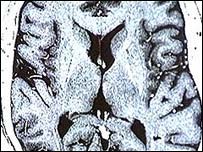 The "chip" reads brain signals
The "chip" reads brain signals |
Brain chip reads man's thoughts
Published: 2005/03/31 - BBC News
A paralysed man in the US has become the first person to benefit from a brain chip that reads his mind.
Matthew Nagle, 25, was left paralysed from the neck down and confined to a wheelchair after a knife attack in 2001.
The pioneering surgery at New England Sinai Hospital, Massachusetts, last summer means he can now control everyday objects by thought alone.
|
|
The brain chip reads his mind and sends the thoughts to a computer to decipher.
Mind over matter
He can think his TV on and off, change channels and alter the volume thanks to the technology and software linked to devices in his home.
Scientists have been working for some time to devise a way to enable paralysed people to control devices with the brain.
Studies have shown that monkeys can control a computer with electrodes implanted into their brain.
Recently four people, two of them partly paralysed wheelchair users, were able to move a computer cursor while wearing a cap with 64 electrodes that pick up brain waves.
Mr Nagle's device, called BrainGate, consists of nearly 100 hair-thin electrodes implanted a millimetre deep into part of the motor cortex of his brain that controls movement.
Wires feed the information from the electrodes into a computer which analyses the brain signals.
The signals are interpreted and translated into cursor movements, offering the user an alternative way to control devices such as a computer with thought.
Motor control
Professor John Donoghue, an expert on neuroscience at Brown University, Rhode Island, is the scientist behind the device produced by Cyberkinetics.
He said: "The computer screen is basically a TV remote control panel, and in order to indicate a selection he merely has to pass the cursor over an icon, and that's equivalent to a click when he goes over that icon."
Mr Nagle has also been able to use thought to move a prosthetic hand and robotic arm to grab sweets from one person's hand and place them into another.
Professor Donoghue hopes that ultimately implants such as this will allow people with paralysis to regain the use of their limbs.
The long term aim is to design a package the size of a mobile phone that will run on batteries, and to electrically stimulate the patient's own muscles. This will be difficult.
The simple movements we took for granted involved complex electrical signals which would be hard to replicate, Dr Richard Apps, a neurophysiologist from Bristol University, UK, told the BBC News website.
He said there were millions of neurones in the brain involved with movement. The brain chip taps into only a very small number of these. But he said the work was extremely exciting.
"It's quite remarkable. They have taken research to the next stage to have a clear benefit for a patient that otherwise would not be able to move. "It seems that they have cracked the crucial step and arguably the most challenging step to get hand movements. "Just to be able to grasp an object is a major step forward."
He said it might be possible to hone this further to achieve finer movements of the hand.
Matthew Nagel's story is featured in a Frontiers programme on BBC Radio Four on Wednesday 13 April, 2005, at 2100 BST.
BBC
|
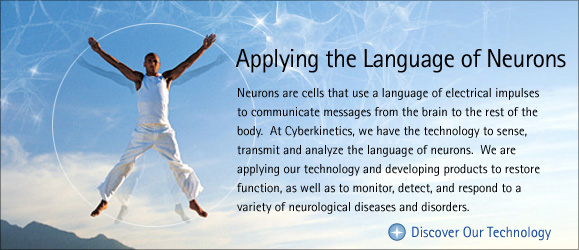
BrainGate - Cyberkinetics Inc. Platform Technology
Neurons are cells that use a language of electrical impulses to communicate messages from the brain to the rest of the body. At Cyberkinetics, we have the technology to sense, transmit, analyze and apply the language of neurons. We are developing products to restore function, as well as to monitor, detect, and respond to a variety of neurological diseases and disorders.
Cyberkinetics offers a systems approach with a core technology to sense, transmit, analyze and apply the language of neurons in both short and long-term settings. Our platform technology is based on the results of several years of research and development at premier academic institutions such as Brown University, the Massachusetts Institute of Technology, Emory University, and the University of Utah.
Sense
Cyberkinetics' unique technology is able to simultaneously sense the electrical activity of many individual neurons. Our sensor consists of a silicon array about the size of a baby aspirin that contains one hundred electrodes, each thinner than a human hair. The array is implanted on the surface of the brain. In the BrainGate Neural Interface System, the array is implanted in the area of the brain responsible for limb movement. In other applications the array may be implanted in areas of the brain responsible for other body processes.
|
|
|
Transmit and Analyze
The human brain is a super computer with the ability to instantaneously process vast amounts of information. Cyberkinetics' technology allows for an extensive amount of electrical activity data to be transmitted from neurons in the brain to computers for analysis. In the current BrainGate System, a bundle consisting of one hundred gold wires connects the array to a pedestal which extends through the scalp. The pedestal is connected by an external cable to a set of computers in which the data can be stored for off-line analysis or analyzed in real-time. Signal processing software algorithms analyze the electrical activity of neurons and translate it into control signals for use in various computer-based applications.
Apply
Cyberkinetics' ability to generate control signals and develop computer application interfaces provides us with a platform to develop multiple clinical products. For example, using the BrainGate Neural Interface System, a person may be able to use his thoughts to control cursor motion and/or replicate keystrokes on a computer screen. In another example, a doctor may study patterns of brain electrical activity in patients with epilepsy before, during and after seizures.
At Cyberkinetics, we are leveraging our core technology to sense, transmit and analyze the language of neurons to developing products to restore function, as well as to monitor, detect, and respond to a variety of neurological diseases and disorders. - cyberkineticsinc.com
|

MY BRAIN WAVES
The human guinea-pig who has mastered mind control
By Nick Webster - 26 May 2005 - Daily Mirror
IN A scene that could have come straight out of a sci-fi movie, Matthew Nagle focuses on the computer screen and, by pure mind control, the cursor begins to move. But the state-of-the-art technology that allows this to happen is no work of fiction. Incredibly, thanks a tiny plug that has been inserted into his brain, Matthew, a quadriplegic, is fighting back against the paralysis which has left him in a motorised wheelchair and unable to breathe unaided.
And as well as moving the cursor, he can play simple games and operate a prosthetic hand, too. The astonishing innovation has brought fresh hope and happiness to the 25-year-old American.
Matthew volunteered to be the first human guinea pig to try the implant, called BrainGate, and believes the technology will eventually help him to walk again.
"I know I'm going to beat this. I've been paralysed for 39 months so I can stick with it another two years, until they get it perfected," he says.
The former van driver was stabbed in the neck during a scuffle at a fireworks display near Boston four years ago. The knife severed his spinal cord and doctors said he would never regain the use of his limbs - but Matthew is determined to prove them wrong.
"I learned to use this device in just two or three days - it's supposed to take 11 months," he says.
The implant is 4mm square with 100 hair-like electrodes which detect brain activity. During surgery a small disc of bone was cut from Matt's skull and the device placed on the surface of the motor cortex area of his brain, which controls movement throughout the body. Fine wires connect to a small metal plate on his head which can be connected to computers to translate Matt's thoughts into movement.
In the future it's hoped the ground-breaking technology will help all disabled people regain their mobility.
But the US defence department sees a very different potential in it - they want to use it so soldiers can control war robots remotely thousands of miles away from the battlefield.
The disability trial in what is known as brain-computer interfaces (BCIs) is being overseen by John Donoghue, a professor of neuroscience at Brown University in Rhode Island.
But his critics believe BCIs will only cause damage to the brains of those involved. Donoghue has already been slammed for implanting the plug directly in Matt's brain, when other less-intrusive and less-dangerous methods are available.
In his defence, he says: "No other method gives the power needed to transform this signal into something a patient can use. There are still issues to be resolved. But it will happen. Just look at Matt."
|
Question: What happens to those of us who might be happy
just the way we are?
Will we be accused of standing in the way of yet another brave new future?
You see, this isn't new...When the industrial revolution happened...
the population were promised a labor free, utopian, robot run world...
nobody had to do any work and life would be ALL pleasure!
Only, I can't help noticing just how many times unemployment is used as the marker
for how economically downtrodden a free market economy has become...!
Will some humans become the robots running other humans utopia?
Will some lucky humans become trans-human via technology
while some unlucky humans become labelled sub-human?
or is that already happening?
are we artificial intelligence?
Consider the vast amount of information that we acquire and process every day. It is difficult to imagine that so much information and activity could be stored in such a small amount of tissue and fluid. Scientists have been theorizing that, indeed, the mind is not as much of a storage device as it is a communications device to some larger "knowledge base." The mind appears to be a way to pre-process data for storage and a way to analyze data for use while all the time maintaining a connection for data storage and acquisition with this knowledge base.
This knowledge base surrounds us with information and intelligence. Everything that every creature in the Universe knows, and will ever know, is stored and made available for us by simply asking for it. However, accessing it requires a connection, a field, which connects us all together in a large "bio-circuit." It can be seen as a "biological parallel computing environment." The information presented by this bio-circuit consists of a limitless and accessible Universal source of knowledge.
Artificial Intelligence
|
I think using the word 'intelligence' is a bit misleading...
doesn't it strike you as being odd that everything we think and feel is being considered only as DATA and intelligence?
That our Brain is being referred to as a device for storing and analyzing DATA?
|
MY IMAGINATION IS NOT JUST DATA, LEAVE IT ALONE!!!
Even now, manufacturers and research groups are experimenting with wearable computers utilizing magnetic and RF sensors embedded in clothing. Wearable computers at the Massachusetts Institute of Technology enable business users to exchange business cards simply by shaking hands (let's try this at MTT-S). Kurzweil believes it will be possible to beam someone your experiences, tapping all five senses.
Science fiction? we know better. Cochlea implants are already rebuilding the hearing of previously deaf patients, and implanted chips have been shown to aid the muscle control of patients with Parkinson's disease. Can you imagine what can be done with wireless interconnect (talk about a resurgence of the wireless industry).
It is estimated that the human brain makes only about 200 calculations per second. The computing machinery available in 2030 will be able to make 100 trillion connections and 1,026 calculations per second (better lay in a good supply of ginko biloba). And the memory footprint 12 million bytes will pale by comparison to computer memory footprints. This means that, literally, artificial intelligence would be five time smarter that we are, just using the process of fuzzy logic. It's awesome to think what such computers might be capable of if they can learn, as well. - Total Recall and You Thought It was Only a Movie
|
|
as Ghandi once said after being asked:
"what do you think of western civilisation?"
he said:
"I think it would be a good idea..."
|
If the brain were so simple we could understand it, we would be so simple we couldn't.
- Lyall Watson, In Philosophy
|
|
